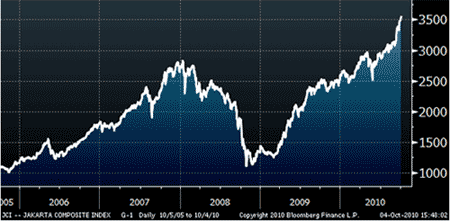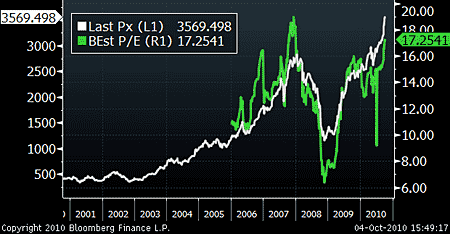Three of the best Asian investment trusts
At the moment, few Asian markets stand out from their peers. So investors are better off taking a broader view of the region than picking one market over another, says Cris Sholto Heaton. Here, he explains the best way to do this, and tips three of the best Asian funds to buy now.

One of the good things about writing MoneyWeek Asia is that I get a steady stream of feedback, which makes me think carefully about my investment views.
For example, when I wrote this markets review a couple of weeks ago, a few readers said that I seemed to have less conviction in one market over another, certainly compared to a year ago.
That's almost certainly true. A year or more ago, there were plenty of reasons to worry. But there were also plenty of signs of value if you kept your head. Now much of that valuation cushion has vanished.
MoneyWeek
Subscribe to MoneyWeek today and get your first six magazine issues absolutely FREE

Sign up to Money Morning
Don't miss the latest investment and personal finances news, market analysis, plus money-saving tips with our free twice-daily newsletter
Don't miss the latest investment and personal finances news, market analysis, plus money-saving tips with our free twice-daily newsletter
That's not to say that nothing at all stands out. But there are fewer bargains around. That means that investors are probably best served by taking a broader view rather than trying to pick one market over another.
Here I want to suggest some of the best ways to do that.
Many Asian markets are hitting new highs
Why it is harder to make high-conviction calls these days? I think the chart below sums it up. This is Indonesia's Jakarta Composite Index. As you can see, it's convincingly broken out to a new record high. And it's not just Indonesia: Thailand and the Philippines are already above their 2007 peaks, while India and Malaysia are likely to pass it within the next few weeks.

Is this a sign that emerging markets are well into a new bubble? I don't think so. It's easy to overlook how strongly Asian corporate earnings have risen in the last year. Just as Asian economies are stronger than the West, so are profits. And that means valuations aren't as stretched as you might expect.
The chart below shows price-to-forecast earnings for the JCI. Unfortunately the estimates data series only goes back a few years - patchy historical figures are the bane of an emerging markets investor's life.

Clearly the forward p/e is at the top of its limited range and more stretched than it was than at any point when I tipped Indonesia in the past couple of years. Even so, 17.3 times doesn't yell "bubble" for an economy that has growth potential of 5-7% a year, likely annual inflation in the 6-8% region (remember valuations need to be judged against nominal rather than real earnings) and improving corporate profitability.
But it does suggest that investors are pricing in quite a lot of good news. Those investors will include quite a lot of foreigners - the Indonesian market is heavily influenced by foreign buying - who may be focusing on the good news and ignoring the country's many problems. These include corruption, poor infrastructure and fractious politics.
That's not to say that the market looks bad value in the long run. Indeed, I could see it rising strongly from here. But it does look vulnerable to any shake-up in sentiment. And I think it's a similar story in many other Asian markets. There are few that stand out as exceptionally cheap relative to each other, once you allow for the risks.
Value in Singapore, small caps and Vietnam
A few exceptions seem to offer a little more value than average. For example, Singapore almost always looks good value to me, offering stability and reasonably good quality companies. As Southeast Asia's financial hub, it will share in the success of its neighbours.
The Straits Times index currently trades on a p/e of 13 (although the p/e based on Bloomberg consensus estimates is a surprisingly pessimistic 15.5 times) and a dividend yield of 2.7%. It's not exactly rock-bottom value. But it's a better deal than the S&P 500 or the FTSE in my view.
Expert tips &ideas for investing in Asia! Claim your FREE guides from MoneyWeek that include:
- How to go about investing to Asia
- Which brokers to use to buy foreign shares
I'd also expect smaller companies to be a good long-term choice in many markets. Smaller and medium sized companies tend to be even more neglected by research analysts in Asia than in Europe and the US, so there's often a great deal of hidden value in this sector.
Investors who are prepared to roll up their sleeves and do the work can eke out some very solid returns. The MSCI Singapore Index had a total return (ie including reinvested dividends) of 62% over the last five years, while the MSCI Singapore Small Cap Index returned 79%. Interestingly, the gap was much smaller when you look at price return only: 34% against 37%, which reinforces the importance of dividends.
Incidentally, this shows up in my portfolio for the Asia Investor email. It wasn't a deliberate decision to focus on these themes - I simply look for the most attractive companies I can find. But at the moment that's delivered a portfolio in which half of the companies are listed in Singapore, with a strong bias towards smaller and medium-sized stocks. Although the focus is on multi-year growth themes, we've been able to take advantage of the good yields still available in Singapore - and a few in Hong Kong - at the same time to get a helpful income stream: at current prices, the portfolio is on an average trailing yield of 3.2%.
At the riskier end of the spectrum, Vietnam continues to look good to me on a long-term view. I've been saying this for some time, and the market continues to do poorly, hurt by muddled policymaking and recent currency devaluations. These will continue to be a problem, but Vietnam has great prospects if it gets things half-way right. The market is on a p/e of aroundten - and it's available at a further 35% discount through an investment trust such as the Vietnam Opportunity Fund (LSE:VOF). Given those figures, I think this is still a good buy for adventurous but patient investors.
Focus on regional funds
Of course, one option when few markets stand out as expensive or cheap is not to worry too much about country allocation, but focus on regional funds. The MSCI Asia ex-Japan is currently on a price/book ratio of 2.05, against a long-run average around the 1.8-1.9 area.
You won't be getting a bargain by taking a regional view right now, but you're not risking overpaying much either and valuations aren't in dangerous territory. History suggests that the point to get worried about a bubble and bust with the MSCI Asia ex-Japan is around 2.5.
So what are the best regional funds to buy? Obviously there are quite a few Asian regional exchange-traded funds (ETFs) now, such as iShares Far East ex-Japan (LSE:IFFF) - which doesn't include India - or db x-trackers MSCI Asia ex-Japan (LSE:XAXJ) or EM Asia (LSE:XMAS). The latter excludes developed markets such as Hong Kong and Singapore.
I don't think these will be bad long-term investments. But I have discussed my concerns about using trackers for emerging markets before. Due to the construction of the underlying index, you often end up with an unbalanced weighting between sectors and with a number of large, poor quality companies in the basket. Some of these reservations definitely apply to these ETFs.
I tend to prefer investment trusts (or closed-end funds as they're known outside the UK). Fees are usually more reasonable than for open-ended funds (Oeics or unit trusts), although still a bit higher than for an ETF. The closed-end structure gives the manager a bit more freedom to invest against the crowd without worrying about temporary underperformance leading to an outflow of money. Funds also often trade at a discount to net asset value. This will often close as the fund's area of investment becomes more popular, giving investors an extra source of return.
I especially like the Aberdeen New Dawn Investment Trust (LSE:ABD), because the Aberdeen team isn't afraid to take views that are very different from their peers. Unfortunately, while this was available at an unusually wide discount of 8-10% to NAV until recently, it's now narrowed to around 2%. But on a long view, I think the fund is still a very good choice.
There are also a few funds that concentrate on small caps. iShares runs the only regional small cap ETF, the Far East ex-Japan Small Cap (LSE:ISFE). Again, this benchmark does not include India. Among the investment trusts, Aberdeen has the Aberdeen Asian Smaller Companies (LSE:AAS), while First State offer the Scottish Oriental Smaller Companies (LSE:SST), on discounts of 3.9% and 7.5% respectively.
Obviously, small caps are more volatile and riskier, but will probably produce higher returns over the long run. If you have the appetite for this and the ability to take the risk, I'd regard any of these three as good long-term investments.
This article is from MoneyWeek Asia, a FREE weekly email of investment ideas and news every Monday from MoneyWeek magazine, covering the world's fastest-developing and most exciting region. Sign up to MoneyWeek Asia here
Asia Investor is a regulated product issued by MoneyWeek Ltd. Your capital is at risk when you invest in shares - you can lose some or all of your money, so never risk more than you can afford to lose. Always seek personal advice if you are unsure about the suitability of any investment. Past performance is not a reliable indicator of future results. Tel: 020 7633 3718
Get the latest financial news, insights and expert analysis from our award-winning MoneyWeek team, to help you understand what really matters when it comes to your finances.
Cris Sholto Heaton is an investment analyst and writer who has been contributing to MoneyWeek since 2006 and was managing editor of the magazine between 2016 and 2018. He is especially interested in international investing, believing many investors still focus too much on their home markets and that it pays to take advantage of all the opportunities the world offers. He often writes about Asian equities, international income and global asset allocation.
Cris began his career in financial services consultancy at PwC and Lane Clark & Peacock, before an abrupt change of direction into oil, gas and energy at Petroleum Economist and Platts and subsequently into investment research and writing. In addition to his articles for MoneyWeek, he also works with a number of asset managers, consultancies and financial information providers.
He holds the Chartered Financial Analyst designation and the Investment Management Certificate, as well as degrees in finance and mathematics. He has also studied acting, film-making and photography, and strongly suspects that an awareness of what makes a compelling story is just as important for understanding markets as any amount of qualifications.
-
 The coming collapse in the jobs market
The coming collapse in the jobs marketOpinion Once the Employment Bill becomes law, expect a full-scale collapse in hiring, says Matthew Lynn
-
 Luana Lopes Lara: The ballerina who made a billion
Luana Lopes Lara: The ballerina who made a billionLuana Lopes Lara trained at the Bolshoi, but hung up her ballet shoes when she had the idea of setting up a business in the prediction markets. That paid off
